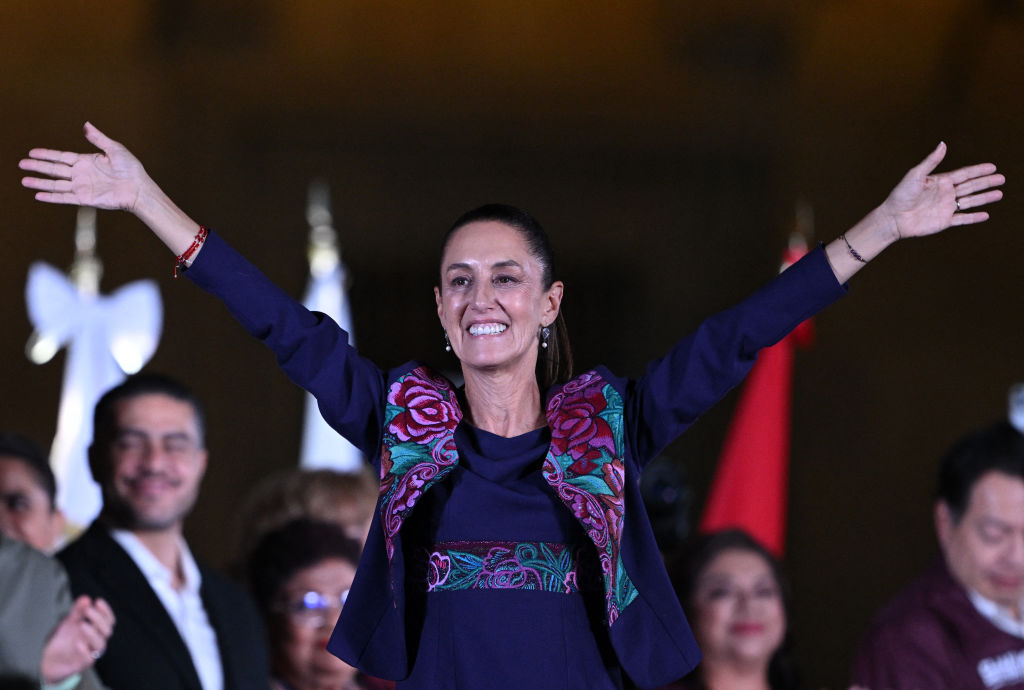Update and correction appended below.
Claudia Sheinbaum won the presidency in a vote that was widely seen as a referendum on her mentor, outgoing President Andres Manuel López Obrador, whose left-leaning policies have proven popular even as his security policy failed to curb drug-related killings. Sheinbaum, 61, received almost 59% of the votes, the highest vote percentage in the nation’s democratic history. She will take office on October 1.
The ruling Morena party appears on track to gain supermajorities both houses of Congress, according to the early official figures. It also won seven of nine governorship races and is now likely set to control 23 of 31 states as well as Mexico City. The main opposition presidential candidate, Xóchitl Gálvez, took only 28.1% of votes, with more than 82% of the votes processed, Mexico City-based newspaper Milenio reported.
Close to 100 million Mexicans were eligible to vote in Sunday’s election, and preliminary figures show participation of around 58%, according the nation’s electoral authority INE. Nine governorships and the powerful position of Mexico City mayor were also up for election. In total, almost 20,000 elected positions were on ballots, the most in Mexico’s history.

Vanessa Rubio
Professor of practice at the School of Public Policy at the London School of Economics (LSE), senior advisor at McLarty Associates
Mexico elected the first woman president in its history, a milestone in itself. Claudia Sheinbaum won by a landslide, with a wider margin than the one AMLO had in 2018. This represents a clear mandate and a hard-to-swallow reality check for many who have yet to understand the desires and aspirations of the many social groups that felt disregarded by previous governments. Trust in government needs to be rebuilt and polarization must be overcome.
The election outcome indicates that Morena and its allies will secure a two-thirds majority in the Chamber of Deputies and likely in the Senate as well. This is a significant development that could pave the way for substantial constitutional changes. Even in gubernatorial races that were expected to be competitive, Morena and its allies have emerged victorious with clear margins, further solidifying their political power.
The election results provide Sheinbaum with a strong mandate for the presidency and ample room to maneuver. Governance challenges will stem from within her own party, in the context of the struggle between radicals and moderates and strengthened organized crime groups.
On the economic front, Sheinbaum’s relationship with the private sector and the quality and level of dialogue with the U.S. are also major challenges, in which the rule of law, trust and certainty will be highly regarded. Sheinbaum will also face her own reality checks, such as an unsustainable fiscal deficit—the highest in 36 years—and the unavailability of Pemex.
Our hopes depend on sensible and responsible leadership from the new administration, and the ability to deliver effective policies to tackle the most pressing challenges that Mexicans face.

Brenda Estefan
Professor at IPADE Business School in Mexico City and a columnist at Reforma, Mexico’s leading newspaper
With the election of Claudia Sheinbaum as Mexico’s first female president, we can expect a nuanced shift in the nation’s foreign relations. Her administration will likely frame international relations through the lens of food, energy, and technological sovereignty and maintain a favorable stance towards Cuba, Venezuela, and Nicaragua while cultivating a relationship with Russia.
Sheinbaum’s administration will probably adopt a stance similar to that of López Obrador, recognizing the crucial importance of North American trade, particularly Mexico’s relationship with the U.S. Here, we might see a change in style but not necessarily in substance. Her choice for chief negotiator for the 2026 review of the USMCA trade deal with the U.S. and Canada will be telling.
Given Sheinbaum’s scientific background, she may prioritize a notable shift toward sustainable development and environmental protection. This could lead to bilateral and multilateral agreements to speed the development and deployment of green technologies. However, should Trump be re-elected in the U.S., such policies might encounter resistance in Washington, especially if they clash with Trump’s deregulation agenda.
Regardless of the outcome of the U.S. presidential election, Sheinbaum will face the challenge of navigating the new strain of U.S. protectionism that began in Trump’s first term and has persisted in the Biden administration. Additionally, her administration must address how Mexico manages the Mexico-U.S.-China triangle, which will be critical in the coming years.
On immigration, Sheinbaum will likely continue Mexico’s role as a key U.S. ally in controlling flows of migrants north while also focusing on addressing the root causes of migration. The ongoing opioid crisis in the U.S. and record levels of violence in Mexico call for new levels of cooperation. Sheinbaum might advocate for a more integrated strategy that includes socio-economic development as a critical component. Her administration will face significant challenges and great opportunities. The question is how effectively she will navigate them.

Ernesto Revilla
Managing director and head of Latin American economics at Citigroup
The Morena coalition won Mexico’s elections in a landslide. AMLO’s successes in reducing poverty and inequality, the extraordinary increase in cash transfers, the increase in real wages, and his domination of the discourse through the mañanera made Morena indomitable in this election.
Sheinbaum is set to confront important economic challenges. The market is currently underpricing fiscal risk in Mexico: the substantial deficit projected for 2024 (6% of GDP) signals the end of the AMLO austerity era. This is not a one-time occurrence, as the government claims. Infrastructure is already lagging in 2024 compared to 2023 and recent history. What has increased is what will be challenging to reduce: pensions, social programs, interest payments, and support for Pemex. Growth is anticipated to decelerate in 2025 and possibly 2026—a hawkish central bank will get some of the blame—while rainy-day savings are meager, given their utilization by the outgoing administration. Morena’s ideology, particularly its state-centric approach to the energy sector, will impede structural solutions for Pemex and other pressing issues.
With a supermajority close to assured, there will be a strong push to pass constitutional changes that move Mexico further toward AMLO’s goal of transforming the country. This might also make it more challenging to defeat Morena in future elections. Mexico will continue its trajectory, set in motion in the last six years, of political centralization and weakening institutions and checks and balances.
While Sheinbaum’s victory speech included the expected moderate macro comments (respect for Banxico, fiscal discipline), the constitutional changes that Morena has proposed, such as an increase in pensions or minimum wage by decree, will in practice make it more difficult to maintain the strong macro fundamentals inherited from decades of orthodoxy. What saved AMLO from his “bad micro” was a “tight macro.” If Mexico continues the trajectory under Sheinbaum and Morena, the latter will be more difficult to maintain going forward.
The initial actions will be key. Sheinbaum is at a crossroads with fantastic opportunities for Mexico on one side of the road and a turning point for the Mexican peso and the eventual loss of investment grade on the other.

Gabriel Casillas
Head of Latin America Economics Research Barclays
Morena’s Sheinbaum won the presidential election by a wider-than-expected margin, while Morena gained a supermajority in the Chamber of Deputies and likely in the Senate. This could mean that outgoing President López Obrador’s reforms submitted to Congress in February could be approved even before Sheinbaum takes office on October 1, as the newly elected legislators will start their term on September 1. These include reduced funding for the National Electoral Institute and structural reform for the Supreme Court—justices would be elected instead of appointed with a rigorous Senate screening.
Sheinbaum’s presidency may well be AMLO 2.0 in terms of fiscal responsibility and respect for central bank autonomy and the FX regime. She may also seek some improvements in terms of the rule of law and openness to green and renewable energies.
Even so, market participants might find it hard to digest Morena’s two-thirds constitutional majorities in the Chamber of Deputies and the Senate. It will be critical to hear what President López Obrador wants to do with the reforms under consideration by Congress. Strong and frontal support for these reforms might affect USD/MXN volatility and, therefore, the central bank’s projected interest rate path, which would likely steer away from many rate cuts.
Along with the fate of AMLO’s reforms, investors will follow Cabinet appointments, especially in the Finance Ministry. Sheinbaum has said that current Finance Minister Rogelio Ramírez de la O will remain in her administration for at least the first six-to-12 months. Markets will also monitor her willingness to reduce the deficit in 2025 from the 5.9% estimated for this year, as well as her decisions on an integral plan for Pemex.
Subscribe to the Americas Quarterly Podcast on Apple, Spotify and other platforms
—
This article was updated to add the percentage of votes obtained by opposition candidate Xóchitl Gálvez, and also to correct the number of governorships Morena won.





